LAHORE: Established by Punjab government, the National History Museum (NHM) at Greater Iqbal Park has preserved the country’s history not only since its creation but also throws light on the struggle of Muslims ruling the sub-continent for centuries.
The mega project was envisaged as a part of the park to educate the new generation of Pakistan about the struggle of their forefathers for a separate country.
The Museum narrates the tale from the independence movement and the picture of first few years of a new born state. The historic events, important statistics and speeches of the leaders of the movement have been displayed at the digital library of the National History Museum while another section of the museum displays pictures and mementos from the British era.
The era from 1940 to 1960, the Pakistan Movement and its inception and the years after have been displayed as a timeline. Similarly, another part of the museum depicts the Lahore Resolution, Pakistan's founding father Muhammad Ali Jinnah's videos, speeches and scenes from migration of Muslims from India to Pakistan at the time of partition in 1947.
“I have crossed eighty fifth year of my age and came here with my grandson. For me it is like moving with history as every wall, every corner introduces us to the struggle of our elders. The pain they suffered, the price they paid for the peace of their people,” Nisha Begum, a senior citizen living in Lahore, told Arab News.
A section at the NHM showcases stories with the help of archives -- newspaper articles, personal letters and firsthand accounts.
This section also shows the scenes of great migration in the country's history as in August 1947, Great Briton left the subcontinent after ruling for 90 years, dividing United India into two separate countries. Millions of Muslims began their journey to West and East Pakistan (presently Bangladesh) while millions of Hindus and Sikhs headed in the opposite direction.
Unprecedented violence with Hindus and Sikhs on one side and Muslims on the other, was witnessed. “The carnage was very intense, with massacres, arson, forced conversions, mass abductions, and savage sexual violence. Some seventy-five thousand women were raped, and many of them were then disfigured or dismembered," according to The New Yorker edition of June 22, 2015.
“I have seen those black days with my eyes. I was a little child at that time. I saw trains arriving with dead bodies. The Muslim sacrificed their lives for a peaceful land but the politicians wasted the struggle. The looters have taken control and the noble lost their dignity,” another senior citizen, Salahud Din, 82, told Arab News.
However, some historians believe that truth was kept from the people in India and Pakistan with self-narrated literature disseminated to further agendas and brain wash people.
“Partition had resulted in the biggest forced migration in the history of mankind and as many as 14 million people, including 10 million from Punjab, were forcefully evicted. Although historians have failed to narrate the violence, but some masterpieces of Urdu literature have highlighted the women’s experiences during Partition,” Dr. Ali Usman Qasmi, historian and Chronologist said during a book launching ceremony at the University of Lahore.
However, the veterans see the 72-year journey of Pakistan with disappointment and hope at the same time.
“The 72-year journey of Pakistan is very unique. A few years after its creation, the country came into the clutches of army dictators and we failed to build a strong system as per our needs. Dictators used the country for personnel gains depriving the people of their legitimate rights,” opined veteran journalist, Chaudhry Khadim Hussain, touching 84 years of age. “I witnessed the creation of Pakistan. People sacrificed their lives, properties and relations in hopes for good but successive military interventions destroyed everything. Even a popular leader like Zulfikar Ali Bhutto failed to complete his agenda,” Hussain added.
Retired General Zia-ud-Din Khawaja had a different point of view. “Despite having nuclear and missile capacity Pakistan never put the world in danger. It always behaved sensibly. Pakistan army played important role not only in the development of the country but also contributed for peace at international level,” Gen. Khawaja said. “Pakistan was created in the name of Islam but unjustified distribution of resources among different segments of society kept the poor away from the blessings,” he added.
Veteran politician Raja Zafrul Haq, who took part in the Pakistan movement, told Arab News that Pakistan was a story of great successes and misfortunes at the same time. The civil governments developed the infrastructure of the country, made her a nuclear power, strengthened its defense but look at what we did with the elected prime ministers whether it was Bhutto or Nawaz Sharif.
“Pakistan significantly lost credibility in the world because of a weak democratic system," said Haq.
Pakistan at 72: a story of success and misfortunes
Pakistan at 72: a story of success and misfortunes
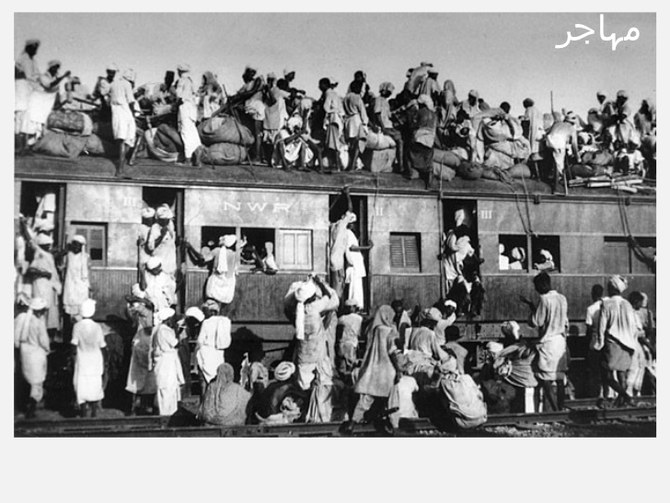
- National History Museum narrates the tale of the country's inception and struggle
- Successive martial laws made Pakistan lose direction, veteran journalist says
PM Sharif and IMF chief meet in Riyadh, discuss Pakistan’s new loan program
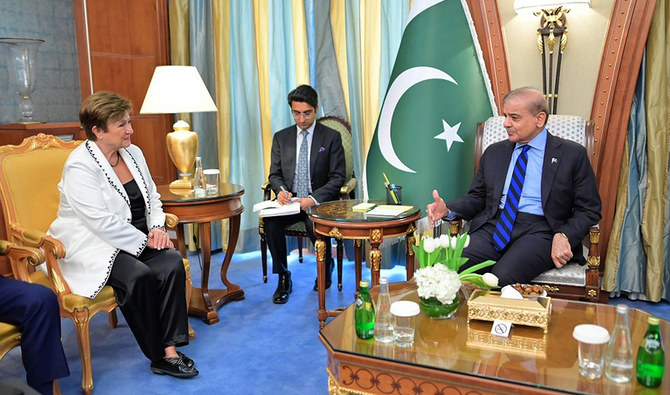
- Pakistan’s $3 billion IMF loan program, which helped Islamabad avert a default last year, is due to end this month
- Pakistan faces a chronic balance of payments crisis, with nearly $24 billion to repay in debt over next fiscal year
ISLAMABAD: Pakistan Prime Minister Shehbaz Sharif on Sunday met with International Monetary Fund (IMF) Managing Director Kristalina Georgieva in Riyadh, where the two figures discussed a new loan program for the cash-strapped South Asian country, Sharif’s office said.
The meeting between PM Sharif and the IMF managing director took place on the sidelines of a two-day World Economic Forum (WEF) summit on global collaboration, growth and energy in the Saudi capital on April 28-29.
Sharif thanked Georgieva for her support to Pakistan in securing a $3 billion IMF loan program last year that is due to expire this month. The IMF executive board is expected to meet on Monday to decide on the disbursement of the final tranche of $1.1 billion to Pakistan.
“MD IMF shared her institution’s perspective on the ongoing program with Pakistan, including the review process,” PM Sharif’s office said in a statement.
“Both sides also discussed Pakistan entering into another IMF program to ensure that the gains made in the past year are consolidated and its economic growth trajectory remains positive.”
Sharif informed the IMF chief that his government was fully committed to put Pakistan’s economy back on track, according to the statement.
He said he had directed his financial team, led by Finance Minister Muhammad Aurangzeb, to carry out structural reforms, ensure strict fiscal discipline and pursue prudent policies that would ensure macro-economic stability and sustained economic growth.
Pakistan secured the $3 billion IMF program in June last year, which helped it avert a sovereign default. Islamabad says it is seeking a loan over at least three years to help achieve macroeconomic stability and execute long-overdue reforms.
Finance Minister Aurangzeb has said Islamabad could secure a staff-level agreement on the new program by early July, though he has declined to detail what size of the program it seeks. If secured, it would be Pakistan’s 24th IMF bailout.
The $350 billion South Asian economy faces a chronic balance of payments crisis, with nearly $24 billion to repay in debt and interest over the next fiscal year — three-time more than its central bank’s foreign currency reserves.
Pakistan’s finance ministry expects the economy to grow by 2.6 percent in the fiscal year ending in June, while average inflation for the year is projected to stand at 24 percent, down from 29.2 percent the previous fiscal year.
Saudi ministers assure PM Sharif of support for Pakistan’s development — PM’s office
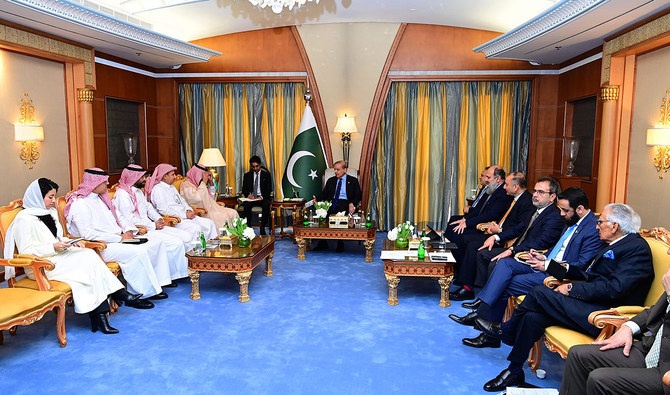
- PM Shehbaz Sharif is in Riyadh to attend WEF meeting on global collaboration, growth and energy
- On Sunday, he met with Saudi Arabia’s minister of finance, investment, and industry and minerals
ISLAMABAD: Prime Minister Shehbaz Sharif on Sunday met with Saudi Arabia’s ministers of finance, investment and industry in Riyadh on the sidelines of a World Economic Forum (WEF) meeting, Sharif’s office said, adding that the Saudi ministers assured him of the Kingdom’s support for Pakistan’s development.
The Pakistan prime minister arrived in Riyadh on Saturday to attend the WEF meeting on global collaboration, growth and energy on April 28-29, after being extended an invitation by Crown Prince Mohammed bin Salman and Professor Klaus Schwab, the WEF executive chairman.
On the sidelines of the WEF meeting, Sharif held separate meetings with Saudi Arabia’s Finance Minister Mohammed Al-Jadaan, Investment Minister Khalid Al-Falih, and Industry and Mineral Resources Minister Bandar Alkhorayef, according to the Pakistan PM’s office.
In his meeting with the Saudi finance minister, the two sides agreed that Saudi Arabia would explore more opportunities for investment in Pakistan.
“The Saudi finance minister reiterated Saudi Arabia’s support for Pakistan’s economic development,” Sharif’s office said in a statement.
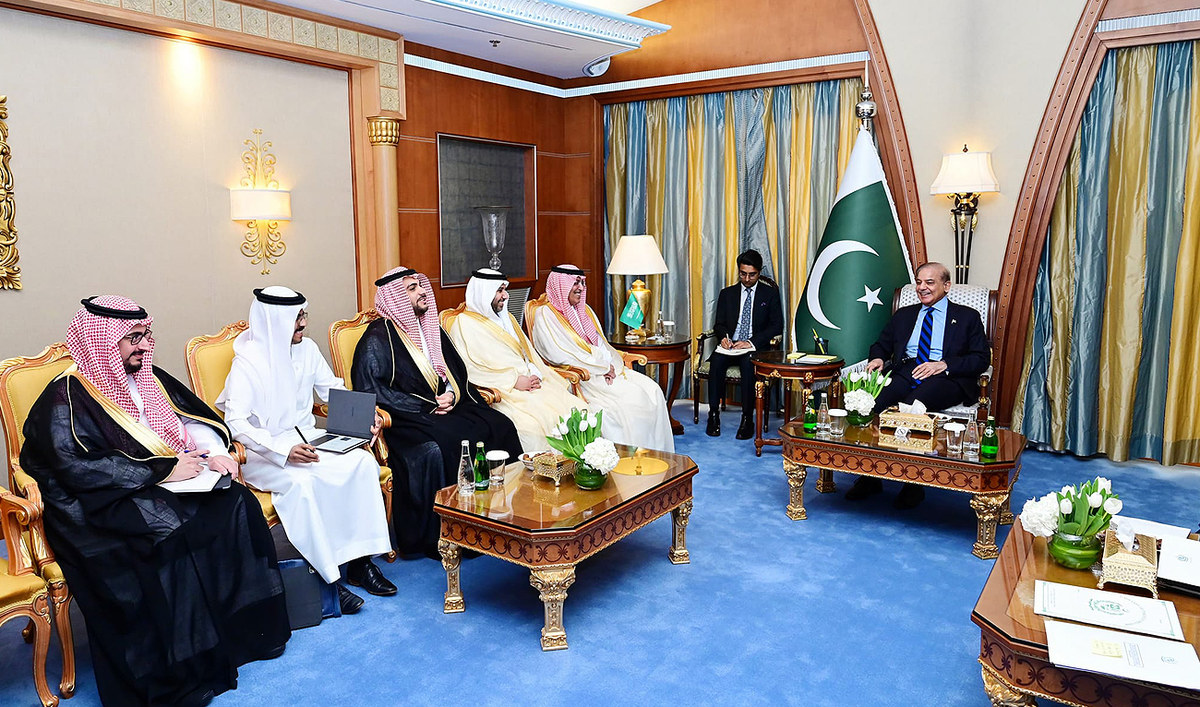
The Saudi investment minister acknowledged PM Sharif’s efforts for Pakistan’s growth and prosperity.
“A delegation of Saudi investors will soon visit Pakistan,” he was quoted as saying by Sharif’s office.
“Pakistan is our priority in terms of investment. Both sides will continue to fully cooperate in agriculture, information technology (IT) and energy sector.”
Pakistan and Saudi Arabia enjoy strong trade, defense and cultural ties. The Kingdom is home to over 2.7 million Pakistani expatriates and serves as the top source of remittances to the cash-strapped South Asian country.
Both Pakistan and Saudi Arabia have been closely working to increase their bilateral trade and investment, and the Kingdom recently reaffirmed its commitment to expedite an investment package worth $5 billion discussed previously with Islamabad.
In his meeting with the prime minister, Saudi Arabia’s Industry and Mineral Resources Minister Bandar Alkhorayef expressed “deep interest” in cooperation with Pakistan in agriculture, minerals, IT and other sectors, according to Sharif’s office.
“I am in touch with Saudi private companies regarding investment in Pakistan and [representatives of] these companies will visit Pakistan very soon,” the Saudi minister was quoted as telling PM Sharif.
“Cooperation between private sectors of the two countries is among our top priorities.”
PM Sharif thanked Saudi Arabia’s King Salman and Crown Prince Mohammed bin Salman as well as the Saudi ministers for supporting Pakistan in every difficulty.
“During my previous government, our economic situation improved, thanks to Saudi Arabia’s support and assistance,” he said, describing both countries as strategic partners.
Pakistan’s Foreign Minister Ishaq Dar, Finance Minister Muhammad Aurangzeb and other members of PM Sharif’s cabinet were also present at the meetings.
Foreign Minister Ishaq Dar appointed deputy prime minister of Pakistan
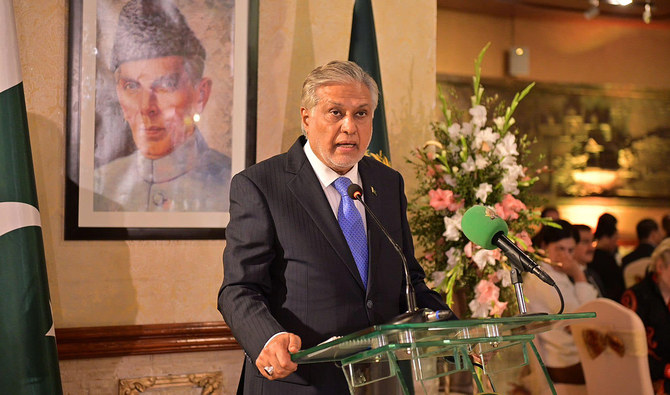
- Dar, a chartered accountant and a seasoned politician, is considered closest ally of Nawaz Sharif, PM Shehbaz Sharif’s elder brother and three-time former PM
- Many believe Dar’s appointment indicates that Nawaz, who didn’t take PM’s office due to split mandate in Feb.8 vote, is trying to assert his control indirectly
ISLAMABAD: Pakistan Prime Minister Shehbaz Sharif has appointed Foreign Minister Ishaq Dar deputy prime minister of the country, the Pakistani government said on Sunday.
Dar, who is a former four-time finance minister of Pakistan, was earlier made the head of a special committee of PM Sharif’s cabinet on privatization.
The 73-year-old chartered accountant is considered to be the closest ally of PM Sharif’s elder brother, Nawaz Sharif, who is also a three-time former prime minister.
“The prime minister has been pleased to designate Mr.Mohammad Ishaq Dar, Federal Minister for Foreign Affairs, as Deputy Prime Minister with immediate effect and until further orders,” read a notification issued from the Cabinet Division.
Nawaz, who returned to Pakistan in October 2023 after having spent years in self-exile, was seen as the favorite candidate for the PM’s office ahead of the Feb. 8 national election and was widely believed to be backed by the country’s powerful army.
But the three-time former prime minister decided not to take the PM’s office after the Feb. 8 vote did not present a clear winner, leading to speculation that his role in the country’s politics had come to an end.
But many believe Dar’s appointment to the deputy prime minister’s slot is an indication that Nawaz is trying to assert his control of government through indirect ways.
Prior to Dar, Chaudhry Pervaiz Elahi was appointed the deputy prime minister of Pakistan in 2012.
In Pakistan’s Peshawar, famed ‘Taj Soda’ has been cooling summers for nearly 90 years
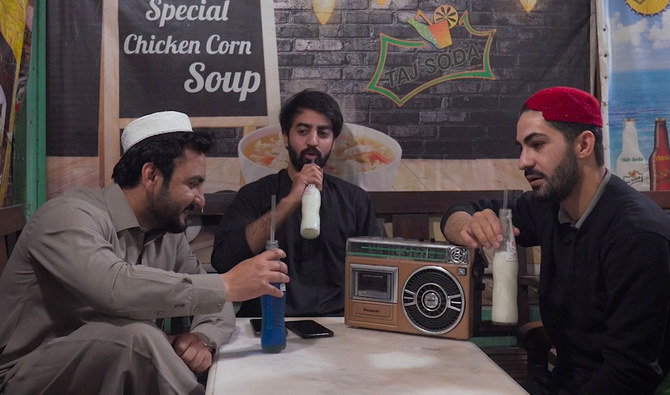
- Taj Soda in Peshawar’s historic Qissa Khwani bazaar offers raspberry, blueberry, mint and several other seasonal flavors
- For some, the establishment, set up in 1936, provides an alternative to the city’s famed ‘qahwa,’ or green tea, in summers
PESHAWAR: One is greeted by the sounds of glass bottles clinking and their brass lids pop-opening as they enter a nearly 90-year-old soft drink outlet, named ‘Taj Soda,’ in the historic Qissa Khwani bazaar in the northwestern Pakistani city of Peshawar.
The visitors are led through a three-feet-wide passage into a hall room, which boasts benches and tables for customers to sit and enjoy their favorite drinks, with its walls adorned with pictures that depict the city’s history through the ages.
Taj Soda, established by Taj Muhammad more than a decade before the partition of the Indian subcontinent, claims to be the “oldest” carbonated drink outlet in Pakistan, which few say provides an alternative to Peshawar’s famed ‘qahwa,’ or green tea, in summers.
“My grandfather’s name was Taj Muhammad, who established this business in 1936. After him, my father Mukhtar Hussain, may he rest in peace, he ran the business for his whole life for 76 years,” Waqas Hussain, Muhammad’s 33-year-old grandson who currently runs the establishment, told Arab News on Friday.
“Our work goes on in six months of summer.”
The outlet, which offers a range of flavors like raspberry, blueberry, pomegranate, apple, rose, banana, mango and mint, is mostly frequented by customers from April till September, though it offers the cherished soft drinks round the year, according to the owner.
A simple drink, made with carbonated water, sugar, sodium citrate and benzoate, is sold for Rs50, while those with the addition of milk cost Rs80.
“We start [selling] soup in winter and we do serve cold drinks, soda water, but it is not like this [as high in demand as in summers],” Hussain said.
Usman Khan, a 21-year-old resident of Peshawar who took a group of friends on a tour of the city, said he brought them to Taj Soda to introduce them to the historic establishment, which was said to be older than even 7 Up, an American brand of lemon lime-flavored, non-caffeinated soft drink.
“They all are my friends, they are from different places. One is from Balochistan and the other is from Kohistan [in Khyber Pakhtunkhwa]. I have brought all of them here,” Khan told Arab News.
“The reason is that it is an old building and was made in 1936. I heard that Taj Soda was established [even] before 7 Up, but this is our bad luck that ... Taj Soda is restricted only to this place. No one knows about it outside [the city].”
But for Hussain, Taj Soda means more than just profit. It is about keeping the legacy of his father and grandfather alive.
“We try not to spoil the name of [our] elders and make the best product, and people trust us,” he told Arab News, with a sense of pride.
“Wherever we go, people know us. We feel happy about it.”
Pakistani court rejects ‘malicious’ social media campaign against judge Babar Sattar
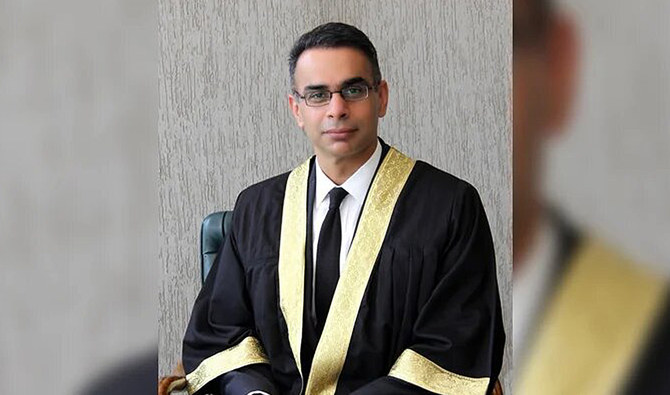
- Statement comes in response to allegations Justice Sattar is a dual national, minted assets after elevation as high court judge
- Justice Sattar is one of six high court judges who spoke of alleged interference by intelligence agencies in judicial matters
ISLAMABAD: The Islamabad High Court (IHC) on Sunday rubbished a “malicious” social media campaign against one of its judges, Justice Babar Sattar, clarifying that he was not a dual national and that all his assets in Pakistan and the United States were legally owned.
The press statement from the Pakistani court came in response to recent social media posts that targeted the judge and members of his family. Some social media users had shared pictures of Justice Sattar’s and his family’s travel documents, suggesting that he was a US national and that he had minted assets after his elevation to the post of high court judge.
Justice Sattar is one of the six IHC judges who accused Pakistan’s premier spy agency, the Inter-Services Intelligence (ISI) of intimidating and coercing them over “politically consequential” cases in a letter written to the Supreme Judicial Council last month.
The letter grabbed headlines following which Pakistan’s Supreme Court took notice of the matter and started hearing the case.
The IHC said in its press release on Sunday that “untruthful” and “malignant” allegations against Justice Sattar were posted on social media along with details of his properties that were mentioned in his tax returns.
“Justice Babar Sattar has never had any nationality other than that of Pakistan,” the high court said. “He studied law at Oxford University as a Rhodes Scholar and pursued graduate education at Harvard Law School.”
The IHC clarified that Justice Sattar worked as a lawyer with a New York law firm and was issued the Permanent Resident Card while he was there in the US.
“He left his job in the US in 2005 and returned to Pakistan and has lived and worked in Pakistan since then,” the press release said.
The court said Justice Sattar’s wife and children are citizens of Pakistan and the US, adding that they had been living in the US till 2021 but returned to Pakistan after he was appointed as a
high court judge. It said that they are now living in Islamabad.
The high court said Justice Sattar’s mother is an educationist who established a school in Rawalpindi in 1992 as its sole proprietor. It added that the judge does not have any ownership interest in the school and is not involved with its management.
“Before being appointed a Judge, his law firm acted as legal adviser to the school and received retainer fee for its legal services,” the press release said.
It said that the judge owns real estate assets in the US and Pakistan that are mentioned in his tax returns. The press release said these assets were scrutinized by the Judicial Commission of Pakistan prior to his elevation as a judge of the high court.
“All real estate assets that he owns are either inherited or were acquired while he was a lawyer,” it said. “He has acquired no real estate assets since his appointment as a Judge. He is not
involved with the management of any business entity.”
The press release concluded by saying the IHC was committed to enforcing and upholding the code of conduct for high court judges, adding that it was accountable to the people as it was an institution that exercised public authority.
















